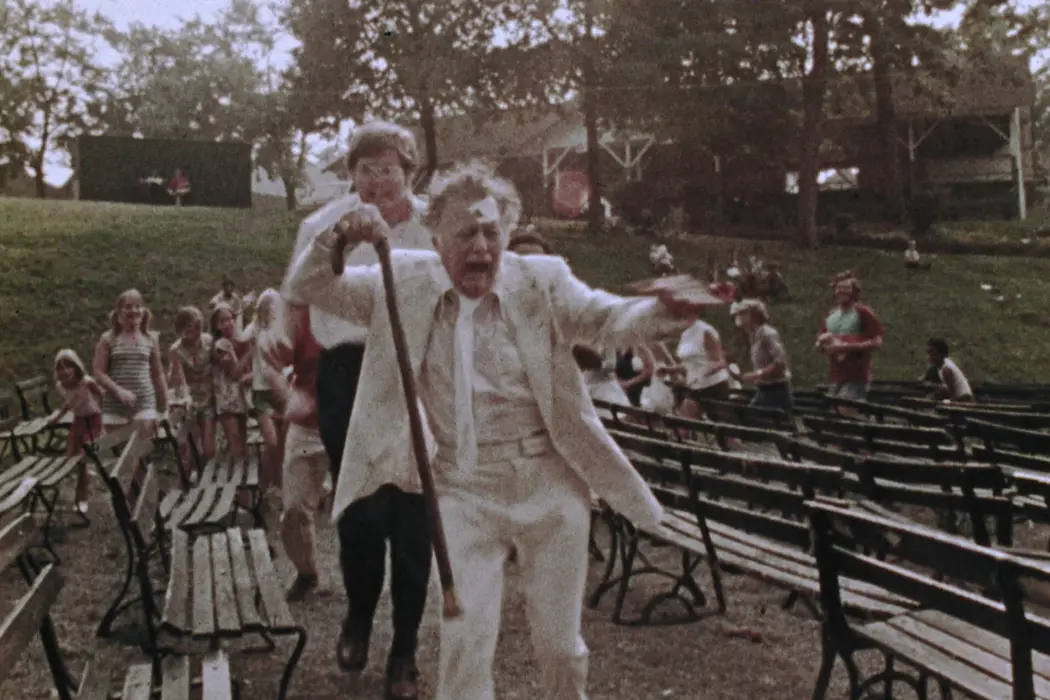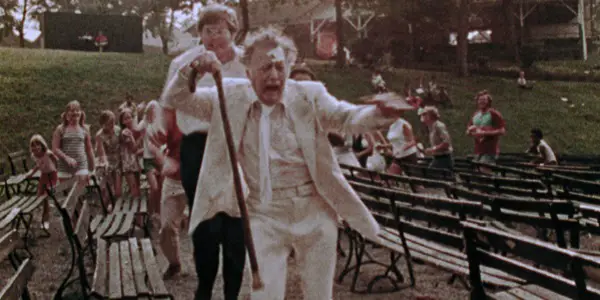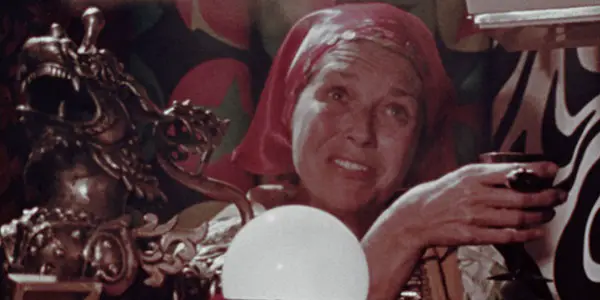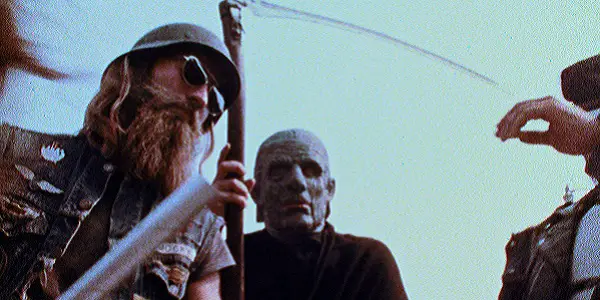THE AMUSEMENT PARK: Welcome to Hell

Lee Jutton has directed short films starring a killer toaster,…
In 1973, the Lutheran Service Society of Western Pennsylvania commissioned an educational film to raise awareness of ageism and elder abuse. The Pittsburgh-based organization enlisted a filmmaker who ran a production company in the area and had a few horror features under his belt—most prominently a black-and-white zombie flick shot in the Pennsylvania countryside that would go on to be a cult classic. That’s right, a nonprofit social ministry organization thought it would be a good idea to hire the one and only George A. Romero, five years removed from Night of the Living Dead, to direct their anti-ageism after-school special.
Needless to say, the finished film that Romero screened for the Lutheran Society was so much more disturbing than what they had originally envisioned that they decided to shelve the film. For 45 years, the film was believed to be lost—then, in 2018, a print was discovered and given a 4K restoration by IndieCollect. Now, the good folks over at Shudder are giving audiences everywhere a chance to finally watch The Amusement Park, Romero’s haunting depiction of the horrors and humiliations that befall the elderly when society deems them excess to requirements. And while The Amusement Park might not feature as much graphic violence and gore as some of Romero’s other movies, that doesn’t make it any less terrifying.
Nightmare Alley
The Amusement Park begins with a brief prologue featuring lead actor Lincoln Maazel, a singer, and actor whose only two film roles were for Romero (this and the 1978 vampire thriller Martin). Walking solo through the empty Pittsburgh amusement park where the film was shot, a then 70-year-old Maazel describes what it feels like to be growing old, and the fears and unpleasantness that bubble up during that process. Younger people often disrespect them, lacking patience and understanding. The inability to get around as easily means an increasingly sheltered, and often very lonely, lifestyle, while physical discomfort and weakness are often dismissed by those who are lucky enough to not yet understand it.

What we’re about to see, Maazel warns, is a cinematic interpretation of those feelings, acted out by a cast of predominantly nonprofessionals. Perhaps the Lutheran Society expected Romero to deliver a series of straightforward vignettes showcasing elderly people dealing with these important issues; instead, what they got was an expressionistic fantasia in which the protagonist, played by Maazel, ignores the warning that “there is nothing out there” and ventures from his safe, sanitized surroundings into the titular park for what he thinks will be a fun day out. What follows is a series of unfortunate events rendered all the more disturbing by Maazel’s naturally sympathetic performance as a man who could be anyone’s kindly grandfather; watching bad things happen to him is not just horrifying, but heartbreaking.
Adventureland
From the very start, Romero uses the familiar visuals of the amusement park as clever metaphors for issues faced by the aged in society. Upon entering the park, Maazel witnesses a group of other elderly people queuing up to get tickets for the park’s various attractions. Lacking the financial stability in retirement to pay cash, many barter beloved family heirlooms for tickets instead. Yet the gruff ticket seller has no appreciation for the history and sentimental value inherent in items like an old pocket watch and refuses to pay out more than five dollars worth of tickets for each one. When Maazel pulls out a wad of actual money and begins carefully shuffling through the bills to see how much he can afford to splurge on tickets, the ticket seller’s lack of patience at the slowness of his movements is uncomfortably clear. Moments later, a woman crashes into Maazel and spills her red drink all over his fresh white suit; rather than apologize, she verbally accosts him for not watching where he is going.

The misguided notion that the elderly must always be at fault because they are assumed to be mentally and physically feeble is an undercurrent throughout The Amusement Park. Later, Maazel manages to pass the eye test required in order to get behind the wheel of the bumper cars, only for the fun to abruptly come to a halt when a younger driver signals one way and turns another, causing a collision with an elderly couple. The whole scenario plays out as though it were actually taking place on the highway, with the younger driver deflecting blame onto the older woman driver, claiming she should have her license revoked just by virtue of being over 65. Meanwhile, she and her husband anxiously answer the questions of a pushy insurance representative, worried that any increase in their rates due to an accident will be too expensive. If they cannot afford their car insurance, they’ll lose the freedom of being able to drive themselves places, and potentially succumb to the loneliness and isolation that affect so many older people.
Death Takes a Holiday
As Maazel goes about his day, the rot at the heart of the amusement park becomes more and more obvious. At one point, he spies the Grim Reaper riding on a carousel, his scythe flashing in the light amidst the faces in the crowd. Rats scurry about amid refuse on a bench that should be a welcome respite for older parkgoers. Maazel says a friendly hello to a group of young children only to be screamed at and called a degenerate for approaching them.
In one extremely trippy sequence, a young couple visits a psychic who promises to show them their future, which involves living in decrepit and unsafe housing that the landlord doesn’t see the point in fixing because the set income of the retired tenants means they don’t pay enough rent for it to be worth his time. The young man is so upset by what he sees that upon emerging from the psychic’s tent, he takes his frustration out on Maazel, attacking him in a misguided effort to show himself and others that for the time being, he is still young and strong.

Not every moment in The Amusement Park lands as powerfully as the ones mentioned above; some are a bit too on-the-nose and feel all the more heavy-handed due to the amateurish performances of some of the volunteers involved. Fortunately, Romero relies more on imaginative visual storytelling than on dialogue and frequently lets the exhausted and disappointed faces of the elderly parkgoers do the talking. The film’s frenetic editing, also by Romero, adds to the chaotic atmosphere, making the audience feel just as overwhelmed by the swirling kaleidoscope of hellish visions plaguing Maazel as he is.
Throughout, Maazel grows visibly weaker, both mentally and physically; his once crisp white suit is tattered and splattered with dirt while his forehead is heavily bandaged from repeated attacks as he staggers around the park, disoriented and distressed. Watching him devolve from being cheerful and positive about life to being downright depressed is extremely painful. If you watch his performance in The Amusement Park and don’t come away with more empathy for the elderly, then you must be immune to the powers of cinema. (Either that or just a bad person.) Unlike many of Romero’s other films, the horrors of The Amusement Park are all too real—and someday, when you’re old, they could happen to you too.
Conclusion
The Amusement Park clocks in at just about 53 minutes, including the aforementioned prologue as well as an epilogue in which Maazel encourages viewers to go out and volunteer with the elderly in their communities. (Personally, I was just relieved to see him happy and healthy again at the end of the movie.) Yet the brevity of the running time only adds to the film’s impact. It’s a shame audiences were denied such a gem for so long—honestly, shouldn’t the Lutheran Society have known better than to hire Romero in the first place? Nonetheless, now that it has resurfaced, The Amusement Park is definitely worth a visit.
What do you think? Are you a fan of George A. Romero? Share your thoughts in the comments below.
The Amusement Park is available exclusively on Shudder on June 8, 2021.
Watch The Amusement Park
Does content like this matter to you?
Become a Member and support film journalism. Unlock access to all of Film Inquiry`s great articles. Join a community of like-minded readers who are passionate about cinema - get access to our private members Network, give back to independent filmmakers, and more.
Lee Jutton has directed short films starring a killer toaster, a killer Christmas tree, and a not-killer leopard. Her writing has appeared in publications such as Film School Rejects, Bitch: A Feminist Response to Pop Culture, Bitch Flicks, TV Fanatic, and Just Press Play. When not watching, making, or writing about films, she can usually be found on Twitter obsessing over soccer, BTS, and her cat.













